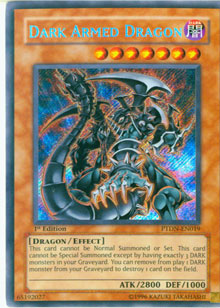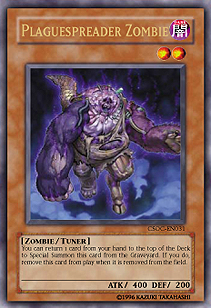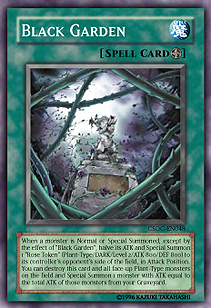Ever since its release in Shadow of Infinity, Karma Cut has been one of those cards hovering at the edge of tournament viability. It’s never seen serious tournament play in past formats; its status as a discard-costed normal trap has always leant it to comparison with Phoenix Wing Wind Blast, a card that has historically been a superior choice. Karma Cut’s own text limits its range of targets to a number of cards far smaller than Wind Blast’s, and that fact (along with the previous popularity of cards like Dimension Fusion and Return from the Different Dimension) led Karma Cut to see no real competitive play.
 . . . Until recently. Over the past several weeks, trends in the Japanese metagame have brought Karma Cut back into the spotlight. And while our metagames here in North America, Europe, and Oceania are very different from those in Japan, it’s made several of us take a second look at this forgotten trap card.
. . . Until recently. Over the past several weeks, trends in the Japanese metagame have brought Karma Cut back into the spotlight. And while our metagames here in North America, Europe, and Oceania are very different from those in Japan, it’s made several of us take a second look at this forgotten trap card.
I, for one, like what I see. Here’s a quick refresher:
Karma Cut
Normal Trap
Discard 1 card. Remove from play 1 face-up monster your opponent controls. Then, remove from play any cards in your opponent's Graveyard with the same name as that monster.
To understand why Karma Cut is a competitive tech choice in this format, you need to understand how it varies from Phoenix Wing Wind Blast. Most decks that opt to run Karma Cut will be doing so by swapping in Cuts over Blasts, so while any discussion of this card needs to begin with how awesome its stunning art is (!), the second logical step is obvious.
What You’re Giving Up
Let’s look at what trading your Blasts for Cuts will cost you.
While Phoenix Wing Wind Blast can spin spell and trap cards and thus help to enable big attack turns, Karma Cut cannot. It can only target face-up monsters. That means it can’t double as temporary spell and trap removal, and it can’t even clear face-down monster cards. Those two abilities, along with the chance to occasionally clog your opponent’s next draw, make Phoenix Wing Wind Blast a more aggressively-minded card. By choosing Cut over Blast you sacrifice some aggressive maneuvers and some flexibility, as Karma Cut is more centered on defense. Note that you’ll still retain the ability to repel all attackers save Thought Ruler Archfiend, and you still have a quick method of discarding a card you’d rather have in your graveyard.
What You Get in Return
As I just stated, Karma Cut is much more focused on defense than Wind Blast ever was, and while Wind Blast can win games, Karma Cut is better at ensuring that you don’t lose them. That’s the difference between a card that temporarily eliminates its target, and a card that removes it from play entirely. Remember that whenever you spin anything with Wind Blast, your opponent will usually draw it again by next turn — sometimes even sooner. The exception here is Synchro monsters, but even then there are advantages to playing Cut over Blast. More on that later.
In the mean time, the first big advantage to Karma Cut is that you can use it to remove monsters you’d virtually never want to return to the top of your opponent’s deck. In a pinch, that means the ability to desperately eliminate Elemental Hero Stratos and Breaker the Magical Warrior — not exactly the kind of cards you want to use two of your own to eliminate, but if it’s necessary, you a least won’t have to see those cards again. At its best, this translates into removed copies of Sangan, Spirit Reaper, and Mystic Tomato: stabilizing cards that, while costly to remove, one would almost never want to hit with Wind Blast. Doing so simply sees that monster returns to the field next turn, stabilizing your opponent against your attacks. It’s great against a copy of Thunder King Rai-Oh that’s locking you out of your search cards, too.
 So it’s good against a multitude of little guys that Wind Blast couldn’t handle as well: great. The real show, and the real reason I like playing Karma Cut lately, is what it does to the big guys. Ever spin Judgment Dragon in response to the activation of its ability? If so, did you win that game? I’m willing to bet you didn’t; it’s much more likely that the Dragon came back next turn and wiped you out anyway. The same can be said for Dark Armed Dragon. In the past, a mix of skill and luck could allow a player to Wind Blast Dark Armed Dragon in response to its effect, leaving the Dragon player to draw it again next turn with only two Darks in his or her graveyard. But that situation gets rarer and rarer these days with players finding more ways to send that third Dark to their graveyards. It was never easy to do in the first place, but refined use of cards like Armageddon Knight, Dark Grepher, and Caius the Shadow Monarch in conjunction with Emergency Teleport has made it nearly impossible to render Dark Armed Dragon a dead card. Spinning it just doesn’t work.
So it’s good against a multitude of little guys that Wind Blast couldn’t handle as well: great. The real show, and the real reason I like playing Karma Cut lately, is what it does to the big guys. Ever spin Judgment Dragon in response to the activation of its ability? If so, did you win that game? I’m willing to bet you didn’t; it’s much more likely that the Dragon came back next turn and wiped you out anyway. The same can be said for Dark Armed Dragon. In the past, a mix of skill and luck could allow a player to Wind Blast Dark Armed Dragon in response to its effect, leaving the Dragon player to draw it again next turn with only two Darks in his or her graveyard. But that situation gets rarer and rarer these days with players finding more ways to send that third Dark to their graveyards. It was never easy to do in the first place, but refined use of cards like Armageddon Knight, Dark Grepher, and Caius the Shadow Monarch in conjunction with Emergency Teleport has made it nearly impossible to render Dark Armed Dragon a dead card. Spinning it just doesn’t work.
But removing it from play? Oho, now we’re talking! No more worries of Judgment Dragon or Dark Armed Dragon coming back a turn later; if your opponent for some reason passes priority, Karma Cut removes the offending monster immediately. If the monster’s ability is activated, Karma Cut on the chain saves you thousands of life points and, in the case of Dark Armed, it likely saves you a few cards as well.
It’s nice against Synchros, too. A lot of players are sloppy in selecting the number of Synchro monsters they run, foregoing second or third copies of important monsters. They don’t care, because they’re anticipating the threat of Compulsory Evacuation Device and Phoenix Wing Wind Blast: cards that return Synchros back to their Extra deck where they can be summoned again. But since Karma Cut removes a Synchro from play instead of kicking it back to the Extra deck, it punishes those players and eliminates their options down the road. It’s not every game that this will be relevant; many are just over too fast for it to matter. But in some portion of your duels, this will mean the difference between winning and losing.
And That’s Just the Half of It
Beyond the range of on-field monsters Karma Cut is better suited to deal with lies a range of in-graveyard monsters it also disrupts. Phoenix Wing Wind Blast does nothing to your opponent’s graveyard, while Karma Cut is great at dealing with a handful of particular cards, eliminating certain big plays from your opponent’s repertoire.
The big one in Japan is Plaguespreader Zombie, a card that up until very recently was literally a plague in that country’s competitive scene. Synchro Zombie decks in Japan were thought to be nearly unbeatable for the latter half of 2008, and Plaguespreader was the chief reason for that. It allowed its controller easy access to control-oriented Synchros in the early game, and created draw loops with Card of Safe Return and Zombie Master. Karma Cut shuts it down, snatching Plaguespreader Zombie from the field before it can be Tuned to another monster. Once that first Plaguespreader is gone and the opponent’s attempted Synchro summon is stopped, the Zombie player then loses all remaining copies of Plaguespreader from his or her graveyard, leaving that player waiting to draw Burial From A Different Dimension.
 Here in TCG territory the play is similar, but the deck is different; Lightsworn is the number one deck in our metagame that we’d find packing multiple copies of Plaguespreader Zombie. The deck quickly sends several Plaguespreaders to the graveyard, making it an easy mark for Karma Cut. The same trick works in the rare instance that a Lightsworn player has a face-up Necro Gardna on the field with one or more in the graveyard, too. Should your attack expose Gardna by flipping it face up, Karma Cut can strip all three copies out of play at once.
Here in TCG territory the play is similar, but the deck is different; Lightsworn is the number one deck in our metagame that we’d find packing multiple copies of Plaguespreader Zombie. The deck quickly sends several Plaguespreaders to the graveyard, making it an easy mark for Karma Cut. The same trick works in the rare instance that a Lightsworn player has a face-up Necro Gardna on the field with one or more in the graveyard, too. Should your attack expose Gardna by flipping it face up, Karma Cut can strip all three copies out of play at once.
Even removing one Krebons from the field to disrupt a Synchro summon, while stripping a second from the graveyard can be devastating. Look at the number of Krebons being run in the Day 2 decks at Shonen Jump Championship Houston: Jerry Wang? Two Krebons. Chris and Kyle Bowling? Two Krebons. Seven of the Top 16 players, including the event’s winner, ran only two copies of the card. Karma Cut can be a major problem for those builds, potentially robbing them of every Tuner they have before they can ever Synchro summon.
Strip away a Lightsworn monster from the field plus a copy from the graveyard to keep Judgment Dragon off the table — or just to harass Lumina, Lightsworn Summoner. Remove Gladiator Beasts from the graveyard to block future copies of Gladiator Beast Darius — it’s a particularly sweet play when you’re chaining Karma Cut to the effect of Bestiari, removing one from the field and one from the graveyard. Even against less popular decks like Zombies and Plants, cards like Mezuki and Lonefire Blossom can be plucked from the graveyard to cause major problems in future turns.
Where to Run It
I’m tempted to try Karma Cut everywhere I’m currently playing Phoenix Wing Wind Blast. It’s got some nice tricks against TeleDAD and other strategies, but it really shines in the Lightsworn matchup, devastating Judgment Dragon and messing with the deck’s graveyard recursion. If you’re like me, you hate going up against Lightsworn because sometimes it throw hands at you that blow you away no matter what you do, and Karma Cut does a lot to stop that.
 Those factors make it a card worth at least testing in a variety of decks, but the number one place I’ve been using it lately is in Black Garden Plants. That deck’s weakest matchup is Lightsworn, so improving the odds there is a massive improvement. However, it’s also important to note that Black Garden’s effect creates plays that don’t exist anywhere else. When your opponent summons a monster with an ignition effect, Black Garden basically "steals" that player’s priority by immediately starting a chain. While you can chain Karma Cut to Black Garden’s effect, your opponent can’t chain his or her ignition effect — ignition effects are spell speed 1, not spell speed 2. Consider the following scenario.
Those factors make it a card worth at least testing in a variety of decks, but the number one place I’ve been using it lately is in Black Garden Plants. That deck’s weakest matchup is Lightsworn, so improving the odds there is a massive improvement. However, it’s also important to note that Black Garden’s effect creates plays that don’t exist anywhere else. When your opponent summons a monster with an ignition effect, Black Garden basically "steals" that player’s priority by immediately starting a chain. While you can chain Karma Cut to Black Garden’s effect, your opponent can’t chain his or her ignition effect — ignition effects are spell speed 1, not spell speed 2. Consider the following scenario.
You control Black Garden with a set copy of Karma Cut. Your opponent is playing Lightsworn, and summons Lyla, Lightsworn Sorceress, wanting to use her effect to destroy Black Garden. When Lyla is successfully summoned, Black Garden’s effect to summon a Token and halve Lyla’s ATK triggers — Lyla’s effect can’t be activated until this chain resolves. That’s good news for me, because I’m going to chain Karma Cut immediately and remove Lyla from play before she can ever touch my Garden.
Not impressed? Replay the same scenario in your head with Judgment Dragon in Lyla’s place. I keep all my stuff, you lose your big hitter, and you can’t even bring it back with Beckoning Light. Consider either situation with Phoenix Wing Wind Blast in Karma Cut’s place, and you can see why I’m playing the Cut over Blast.
Karma Cut will be scoffed at over the coming weeks by lots of people, especially those who try it in TeleDAD and find it to be underwhelming in the mirror match on their first outing. However, if you play it long enough to truly master it, it can become a viable option for many decks you build in the future, as well as plenty of strategies that you run right now. There’s a tremendous amount of potential here: Karma Cut’s a unique card with some great tricks, and learning them could take you to the top of a Regional or Shonen Jump Championship. It’s a great defense against the two best monsters in the game and it’s also chainable: no other card can match that.
-Jason Grabher-Meyer